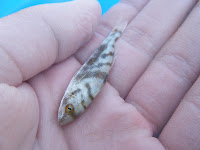
These incredible crustaceans, denizens of the sandy bottom of the shallows in the Gulf of Mexico, were caught a few weeks ago while I was playing in the surf. The top left is what I believe to be a slipper lobster. This crustacean, while it has no claws, (that is not what it felt like to me), uses this enlarged antennae to dig through the sediment in search for food. (Again, not what I am seeing, identification is welcomed). They are opportunistic feeders and will eat whatever happens to come their way, whether it is a dead fish or some shrimp.
This second picture is of what is commonly known as a sand flea. These small burrowing crustaceans, when uncovered, can disappear into their gritty home with startling speed and fluidity. Simply digging a hole at the edge of the surf zone can uncover hundreds of tiny ones or maybe a fairly large one, one to two inches long. My library of reference books has very little about the sand flea, so I don't know what they eat or their habits. Help is wanted!!






































